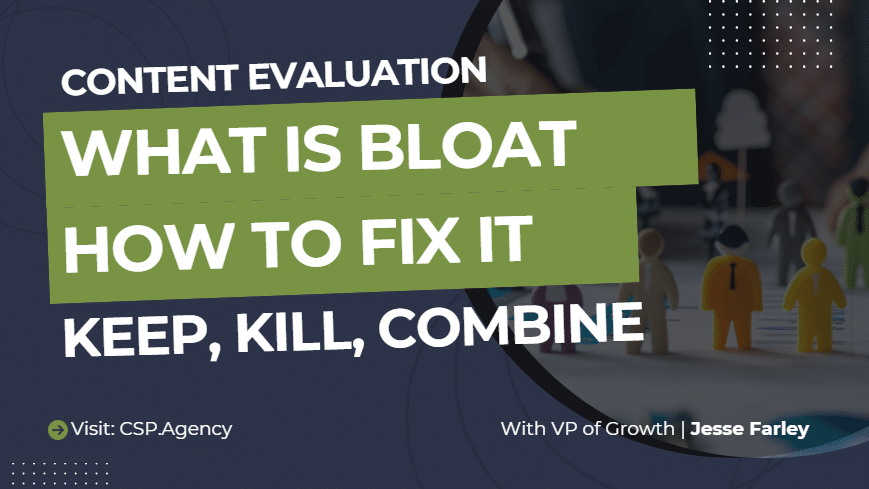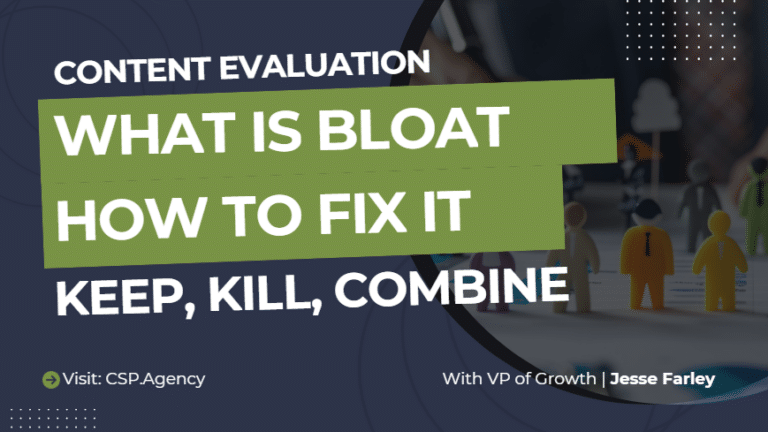How To Cut Back The Content Bloat In Your Website
As far as marketing strategies go, content marketing is crucial for your business. However, in the race to build a sizable content library, you may be doing more harm than good. Not all content is created equally, and poor-performing pieces could impact your SEO rankings.
This problem is known as “content bloat,” and it’s a relatively easy issue to solve, provided that you know what it is and how to spot it. In some cases, eliminating bloat can be one of the best value-driven content strategies for your brand. So, let’s break down what it takes to address content bloat.
What is Content Bloat?
Content bloat is loosely defined as non-performing or underperforming content on your website. Maybe the content is old and outdated, or maybe it just never got the traction it was supposed to. No matter the cause, content bloat can gum up the works and cause your website to fall in SERP results.
But why is bloat so toxic for your site? There are several reasons:
- First, the more pages you have on your site, the longer it takes for web crawlers to index the entire thing.
- Next, if someone wants to find a piece of content in your archives, doing so can be a lengthy ordeal as they search through tons of old articles.
- Depending on how much bloat your site has, it may slow the overall speed of your landing pages, which will increase your bounce rate.
- Finally, if your content bloat is full of broken links (either internal or external), search engines may flag the pages and penalize your site accordingly.
Evaluating Pages for Content Bloat
Knowing the danger of bloat is one thing, but how can you make sure a piece fits these parameters? Additionally, what can you do once you identify underperforming content? A content audit is the simplest and most effective solution; so much so that you should incorporate it into your existing value-driven content strategies.
As you conduct your content audit, you should categorize each piece into three sections: good, needs work, and bad. Here’s a quick overview of each option:
- Good Content – This is content that is engaging, drives traffic to your website, and boosts your domain authority. Some pieces will keep performing well over the long term, while others may have worked well for a specific campaign.
- Needs Work – This content may not have moved the needle as much as you would have liked. Maybe it’s because of external variables like timing or promotion, or it could be that the piece itself just isn’t very captivating. Overall, content that “needs work,” has potential but may need to be redone to help it get the traction it deserves.
- Bad Content – From an SEO perspective, “bad” content is anything that barely adds value to either your marketing campaign or user experience. Maybe the content is bland, or perhaps it’s too repetitive or irrelevant. Sometimes, bad content may have a few valuable nuggets, but it’s much better to rework them into new pieces than squeeze value from a dud.
As you’re evaluating old content, keep in mind your marketing goals and make sure each piece aligns with those objectives. Also, keep in mind that your campaign strategy may have been different when producing an old piece, so now you have a chance to refresh it to be more relevant to your current marketing tactics.
For example, let’s say there was a blog post that was designed to boost your subscriber list. One way to tell if the piece is good, bad, or needs work is to see how many subscribers you got from it. If the goal was 100 and you only received five, it’s probably bad content. However, if you have 80 subscribers, it may just need a refresh, and you can still get value from it.
How to Fix Content Bloat
Once you’ve categorized all of your content, the next step is “keep, kill, combine.” As a general rule, you should keep good content (and maybe even republish it on other platforms), kill bad content, and combine content that underperformed but still has potential.
But what if you have links to content that you will combine or refresh? That’s where a 301 redirect comes into play. A 301 redirect is a permanent adjustment that forwards users to a new URL. This way, when someone clicks an old link (or enters an old URL), they’re redirected to the new page instead of receiving a 404 Not Found error.
You don’t always need to redirect old content, but it works well if you’re updating a high-performing piece or high-traffic landing page. This way, you can still capture the traffic for the old URL and build your audience.
If you’re reworking content, keep these factors in mind:
- Audience – Person-first content is king on search engines, so make sure each piece is as relevant and valuable to your target audience as possible.
- Marketing Objectives – What do you want to achieve with this specific blog post, video, or infographic? Is it tailored toward that goal already, or do you need to change it accordingly?
- Engagement – Beyond value, is your content enjoyable to read or experience? Does it align with your brand’s values and tone? What separates this piece from any other similar content?
Let CSP Deliver Value-Driven Content Strategies for Your Business
Removing content bloat can be an overwhelming experience, especially if you have years of content to sift through and update. Instead of handling it all yourself, let the SEO experts at CSP do it for you. We know what gets traction and engagement, and we can help you refine your old content to perform as well as possible. Contact us today to schedule your content audit.


